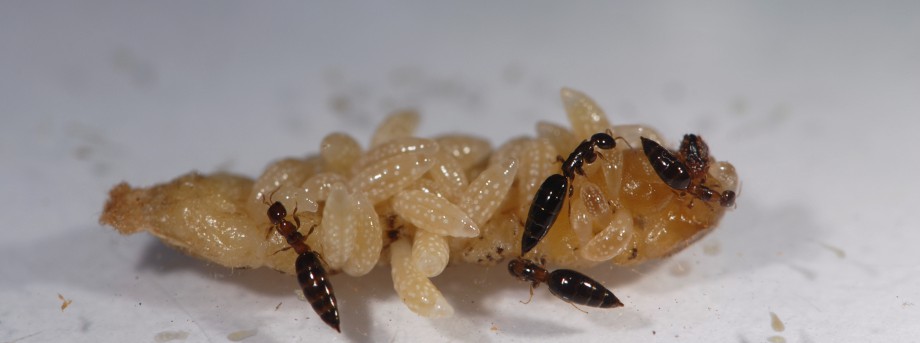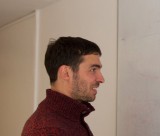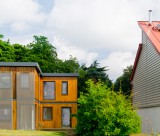The University of Nottingham
 Exchange online
Exchange online
Research Exchange
Taking the ‘sting’ out of reproduction

September 12 2014
Female parasitic wasps have more reproductive success when working together with other females, which can also explain sex biased reproduction, according to new research.
In a collaborative study published today in Nature Communications, scientists from The University of Nottingham’s School of Biosciences, and from Nanjing Agricultural University and the Forest Academy of Jiangsu Province in China, looked at the social behaviour of parasitic wasps to find out how successfully they reproduce when operating alone, in the presence of another female or when part of a larger group.
A parasitic wasp’s purpose is to reproduce and to do this they need a host, such as a beetle larva. When an adult female wasp finds a host, they paralyse it by injecting it with venom. They then lay one or more eggs into the host or on them externally. The host remains alive until the parasitoid larvae are mature, but dies before the larvae emerge as adults.
The mature wasp is ready to carry on the reproductive cycle soon after it emerges from the host. Because of this, wasps are considered important as an environmentally safe means of pest control and are frequently used in agriculture as they often attack pest insects and are beneficial to crops.
Shared resources
Nearly all parasitic wasps operate alone and previous studies have shown that if a second female lays a clutch of eggs onto the same host, this is a disadvantage for the first female because her offspring will have to share the resources available.
In this new study, academics conducted a very simple experiment, taking a variety of hosts in different sizes and varying the number of adult female wasps that could attack it from one to eight.
Dr Ian Hardy, Associate Professor and Reader in Animal Population Biology and co-author of the report, said: “Some wasps have aggressive host guarding behaviour, so amother will find a host, sting it, lay her eggs and stay with her eggs until they hatch. She will stop others eating the eggs and adding their own eggs by fighting them off.
“What we’ve seen in our study was that on a larger host, a lone female was unlikely to obtain any offspring from it. However, if there were a number of females there, the chances of offspring are greatly increased. This shows that sharing resources (the host) can lead to direct benefits to the individual mothers: this is a very unusual result for parasitic wasps. It is especially interesting because social behaviour, such as cooperative brood care, is often explained by close genetic relatedness between the females, but in the wasps we studied, the benefits of sharing do not depend on kinship.”
Female biased sex ratios
Another outcome of the research was to indicate why the sex ratios of these wasps are extremely female biased (only around 3% of offspring are males). Mother wasps, once mated, have control over the sex of their offspring – to produce a son, they simply lay an egg without fertilising it, while fertilised eggs develop into daughters.
Dr Hardy continues: “A lot of parasitic wasps have female biased sex ratios – often because the group is the product of one mother, whose offspring will mate with each other. Biasing the sex ratio reduces mate competition between sons and maximises the number of eventual grandchildren. Normally, when the offspring of several mothers mate together, it pays mothers to have less biased sex ratios as their sons can mate with the daughters of other mothers.
“In contrast, in the cooperative wasps we have recently studied we did not see a large change in sex ratios when the number of mothers producing offspring on a host increased. Instead it pays mothers to produce very biased sex ratios because when their daughters mature and search for hosts, it is advantageous to have the daughters of other mothers around to help suppress the host.
“So, the benefits of communally attacking large hosts also lead to unusually female biased sex ratios, all because females mutually enhance each-others’ environments, rather than being a source of competition.’’
To read the full report visit http://www.nature.com/naturecommunications (DOI: 10.1038/ncomm5942).
Tags: Animal Population Biology, Dr Ian Hardy, Forest Academy of Jiangsu Province, Nanjing Agricultural University, Nature Communications, parasitic wasps, reproduction, research, School of Biosciences, sex biased reproduction, social behaviour
Leave a Reply
Other News

Top prize for quantum physicist
A University of Nottingham physicist has won a prestigious medal from the Institute of Physics for […]

Zero carbon HOUSE designed and built by students comes home
Design and construct a low cost, zero carbon, family starter home, transport it to Spain, build […]